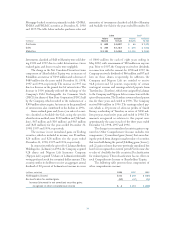American Express 1998 Annual Report Download - page 40
Download and view the complete annual report
Please find page 40 of the 1998 American Express annual report below. You can navigate through the pages in the report by either clicking on the pages listed below, or by using the keyword search tool below to find specific information within the annual report.
38
1998 1997
Held to Available- Held to Available-
(millions) Maturity for-Sale Maturity for-Sale
Purchases $ 692 $ 9,927 $ 64 $ 7,323
Sales $ 243 $ 1,413 $ 274 $ 1,504
Maturities $ 2,191 $ 5,524 $ 1,513 $ 2,965
Mortgage-backed securities primarily include GNMA,
FNMA and FHLMC securities at December 31, 1998
and 1997. The table below includes purchases, sales and
maturities of investments classified as Held to Maturity
and Available-for-Sale for the years ended December 31:
Investments classified as Held to Maturity were sold dur-
ing 1998 and 1997 due to credit deterioration. Gross
realized gains and losses on sales were negligible.
The change in the Net Unrealized Securities Gains
component of Shareholders’ Equity was an increase of
$4 million, an increase of $193 million and a decrease of
$489 million for the years ended December 31, 1998,
1997 and 1996, respectively. The increase in 1997 was
due to a decrease in the general level of interest rates. The
decrease in 1996 primarily reflected the exchange of the
Company’s Debt Exchangeable for Common Stock
(DECS) for shares of First Data Corporation (FDC) held
by the Company, which resulted in the realization of a
$300 million after-tax gain. An increase in the general level
of interest rates also contributed to the decline in 1996.
Gross realized gains and (losses) on sales of securi-
ties classified as Available-for-Sale, using the specific
identification method, were $130 million and ($42 mil-
lion), $67 million and ($10 million) and $65 million
and ($25 million) for the years ended December 31,
1998, 1997 and 1996, respectively.
The increase in net unrealized gains on Trading
securities, which is included in income, was $3 million,
$24 million and $28 million for the years ended
December 31, 1998, 1997 and 1996, respectively.
In connection with the spin-off of Lehman Brothers
Holdings Inc. (Lehman) in 1994, the Company acquired
928 shares and Nippon Life Insurance Company
(Nippon Life) acquired 72 shares of Lehman’s redeemable
voting preferred stock for a nominal dollar amount. This
security entitles its holders to receive an aggregate annual
dividend of 50 percent of Lehman’s net income in excess
of $400 million for each of eight years ending in
May 2002, with a maximum of $50 million in any one
year. Prior to 1997, the Company received no dividends
in connection with the earnout. In 1998 and 1997, the
Company received a dividend of $46 million and $7 mil-
lion on these shares, respectively. In addition, the
Company and Nippon Life are entitled to receive
92.8 percent and 7.2 percent, respectively, of certain
contingent revenue and earnings-related payouts from
Travelers Inc. (Travelers), which were assigned by Lehman
to the Company and Nippon Life in connection with the
spin-off transaction. The Travelers revenue-related payout
was for three years and ended in 1996. The Company
received $46 million in 1996. The earnings-related pay-
out, which is 10 percent of after-tax profits of Smith
Barney, a subsidiary of Travelers, in excess of $250 mil-
lion per year, was for five years and ended in 1998. The
amounts recognized in relation to this payout were
approximately the same in each of the three years ended
December 31, 1998, 1997 and 1996.
The change in net unrealized securities gains recog-
nized in Other Comprehensive Income includes two
components: (1) unrealized gains (losses) that arose dur-
ing the period from changes in market value of securities
that were held during the period (Holding gains (losses)),
and (2) gains or losses that were previously unrealized, but
have been recognized in current period Net Income due
to sales of Available-for-Sale securities (Reclassification
for realized gains). This reclassification has no effect on
total Comprehensive Income or Shareholders’ Equity.
The following table presents these components of
other comprehensive income:
(millions, net of tax) 1998 1997 1996
Holding gains (losses) $61 $ 230 $ (463)
Reclassification for realized gains (57) (37) (26)
Increase (decrease) in net unrealized securities gains
recognized in other comprehensive income $4 $ 193 $ (489)
























